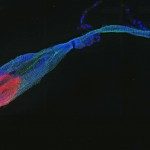Lien vers Pubmed [PMID] – 17971873
PLoS ONE 2007;2(10):e1110
BACKGROUND: CXCL12alpha, a chemokine that importantly promotes the oriented cell migration and tissue homing of many cell types, regulates key homeostatic functions and pathological processes through interactions with its cognate receptor (CXCR4) and heparan sulfate (HS). The alternative splicing of the cxcl12 gene generates a recently identified isoform, CXCL12gamma, which structure/function relationships remain unexplored. The high occurrence of basic residues that characterize this isoform suggests however that it could feature specific regulation by HS.
METHODOLOGY/PRINCIPAL FINDINGS: Using surface plasmon resonance and NMR spectroscopy, as well as chemically and recombinantly produced chemokines, we show here that CXCL12gamma first 68 amino acids adopt a structure closely related to the well described alpha isoform, followed by an unfolded C-terminal extension of 30 amino acids. Remarkably, 60% of these residues are either lysine or arginine, and most of them are clustered in typical HS binding sites. This provides the chemokine with the highest affinity for HP ever observed (Kd = 0.9 nM), and ensures a strong retention of the chemokine at the cell surface. This was due to the unique combination of two cooperative binding sites, one strictly required, found in the structured domain of the protein, the other one being the C-terminus which essentially functions by enhancing the half life of the complexes. Importantly, this peculiar C-terminus also regulates the balance between HS and CXCR4 binding, and consequently the biological activity of the chemokine.
CONCLUSIONS/SIGNIFICANCE: Together these data describe an unusual binding process that gives rise to an unprecedented high affinity between a chemokine and HS. This shows that the gamma isoform of CXCL12, which features unique structural and functional properties, is optimized to ensure its strong retention at the cell surface. Thus, depending on the chemokine isoform to which it binds, HS could differentially orchestrate the CXCL12 mediated directional cell kinesis.

